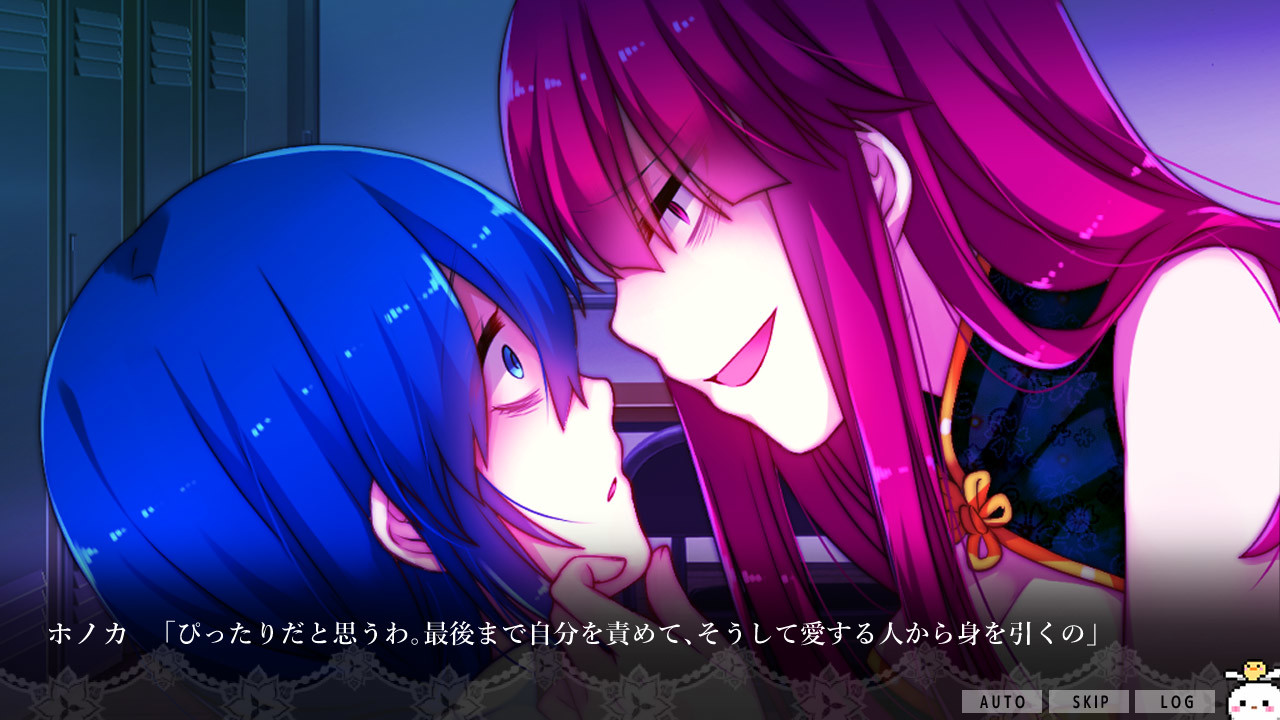Yandere Horror VNs – Genre Deep Dive
This is a condensed version of the full article which can be found on my Main Blog Here.
Obsessive Love
The Yandere is perhaps the most iconic ‘Dere’, not just within visual novels but within the more general anime fandom, with their distinctive mix of love and violence, they have found their way into everything from Comedy to Slice of Life. It is the particular combination of Yandere and Horror that is the focus today and the way this niche aspect of visual novels has captured the hearts of many. For what appears to be a simple concept at first sight, there is a surprising amount of variety to the Yandere through how they create fear as well as how they play into the work in its totality. On top of this, the normal side to a Yandere’s personality has a lot a posibilities to it which helps obfuscate the Yandere and suprise the player, but also provide a humanising element to drive home the contradiction in their nature. So let’s lock our crush in the basement and examine this fascinating sub-genre.
Defining The Yandere
In short, a Yandere is an individual who initially appears to be normal and caring but once the mask drops reveals themselves to be willing to resort to violence, be that against the target of their affection or those around them, in order to right something they perceive as intruding on their idealised vision of a relationship. The mental instability which characterises them when the mask is off is focused around this idea of violence, but this does not always mean it has to be physical in nature and more often than not it is a psychological angle that the Yandere takes to achieve their desires. In turn there is also an elemement of them being true to that desire in a way no other type of character can be. This would almost be an admirable trait if not for the extreme to which they take it. It is these extremes surrounding their romances that separates the Yandere from someone who is merely possessive and manipulative and it is in them where the horror finds its material. Their mask or ‘dere’ side is not a completely fake exterior and instead is a more even version of their true nature crafted to allow them to exist in society. They are a presentation of the way human interactions and hierarchies change a person and how it twists our true selves taken to its logical extreme in pursuit of the one thing that might set them free, the unconditional love of another. Through the combination of these two halves the idea of the Yandere has burned itself into our consciousness and is ripe for exploiting to create a sense of fear.
A Matter Of Degrees
When it comes to the usage of the Yandere in horror there are broadly two ways of integrate it into the narrative, make it the sole focus or use it to highlight a specific moment. These two offer vastly different executions of the Yandere due to their contrasting uses of space and their differing aims. However, this contrast reveals some interesting aspect of the sub-genre.

Forming a game around the concept of Yandere Horror presents some interesting challenges, especially since the focus on a Yandere is often used as the primary selling point of the title and as a result the player already has some idea about what is going to happen. So rather than try to pretend that the Yandere is not going to appear, they instead lean into this inevitability as a source of tension and dread as the player knows that the peaceful life and love presented to them will end soon and this makes them jumpy at even the slightest sign that something is wrong. This technique is exaggerated by the way these games make the real Yandere hard to spot and giving other characters red herring personality traits to throw people off and the player is often led to jump at shadows or misread the situation as they too slowly descend the spiral towards paranoia. Traumermaid provides a good example of how these ideas are implemented in practice. It plays up the cliches of returning to your home town after an absence as well as being reunited with childhood friends to create an almost inviting atmosphere. However, from the very start something is subtly off and the player can feel it but it is difficult to pin down exactly what it is that makes them feel this way. Only as the curtain is pulled back and the illusion of peace shattered does the source of this fear become clear. Assisted by its leanings into the trappings of fairy tales, the encroachment of the Yandere pulls the player deeper into the spiral of disaster. Drawing the entire experience around Yandere Horror is an all consuming task for a game and in turn that is felt by the player.
Tension Between Desire, Love and Ownership
The aspects of the Yandere which horror utilises all revolve around the ways they reflect back onto us the darker parts of our desire and relationships, the thoughts we never act upon. Ownership is the idea the Yandere taps into the most with them often becoming paranoid that the target of their affection might be stolen away from them. We all want to be the focus of our partner's affection and may even get a little jealous when they turn to talk to others, but, since most people are well balanced enough to realise these feelings are illogical, we do not act on them. However, the fact that those thoughts existed inspires a quiet fear of our own thoughts and what sort of person we would be if we acted upon them and a hope that nobody else would act on similar thoughts against us. By contrast the Yandere does not have that filter or self control and so acts on this part of themselves and as a result are a figure we can empathise with while also fearing since we know what their desire demand and what it means for us. Building a bond between the player and the Yandere before the inevitable decay into madness is key for this element of Yandere Horror to work correctly and The Way We All Go showcases this set up extremely well. It achieves this through mixing in romance to the formula to humanise the Yandere and deal with them within an everyday context to drive home just how similar to the player they really are before they lose control. The banality also acts as a contrast to the extremes of the acts performed later by the Yandere and they stand out all the more, but at the same time these actions calls back to those simpler times to make it clear where the Yandere’s line of logic originated from. Sometimes there is nothing scarer than a person pushed to their limits.

What Lurks Behind The Smile
People can be scary, they hide their true intentions behind masks to get what they want or lie to play the social game to the point that we can never be truly sure we know even our closest friends. While this line of logic is mostly just nonsense as very few people are actively out to get you, the thoughts which lead to it have a power over our imagination perfect for Yandere Horror. The Yandere is the epitome of this fear with a loving exterior concealing their violent and dark inner thoughts. Playing into this concealment is by far Yandere Horror’s greatest tool as it makes even the simplest actions come across as suspicious to the player in order to build up tension or creates a greater sense of betrayal and being up the creek without a paddle. Tapping into this opportunity requires the game to commit a decent amount of time as YOU and ME and HER: A Love Story does with a large section of its first half being used to presenting a veneer of sanity and normality for both the characters and the setting. A lot of effort is placed into preventing the player from sniffing out what is going to happen and at the same time creating a feeling of unease that the player wants to shake off as their own natural paranoia. The game’s use of fourth wall adds a directness to this switch as the person being addressed by the Yandere’s darker desires is not some in game character but instead the player themselves. This breaking of the fourth wall follows the same escalation as the treat posed by the Yandere and this ensures that it does not come across as silly due to a smother transition into these elements.

Conclusion
The Yandere is an odd creature, at once loving and faithful yet also violent and possessive, but it is exactly this contradiction that makes it the perfect subject for visual novel horror. This can be the entire focus of the experience or just an aspect to highlight a key moment. Regardless of which is chosen both share the common desire to play up the tension of the Yandere’s reveal and actions around the player character. Much of the fear invoked by the Yandere is born from how their actions are exaggerated version of our own thoughts. They act on the parts of ourselves we would rather deny, our possessiveness, jealousy and fear of the two faced nature of humans. So when the Yandere appears before us it is a mirror onto our own faults and the urge to look away is just as strong as the desire to stare in facination. Yandere Horror is a fascinating sub-genre and spreads well beyond the visual novels covered here and, since it works well as a supplementary element, there is a lot of explore if anything here has tickled your interests.



0 Comments
Recommended Comments
There are no comments to display.